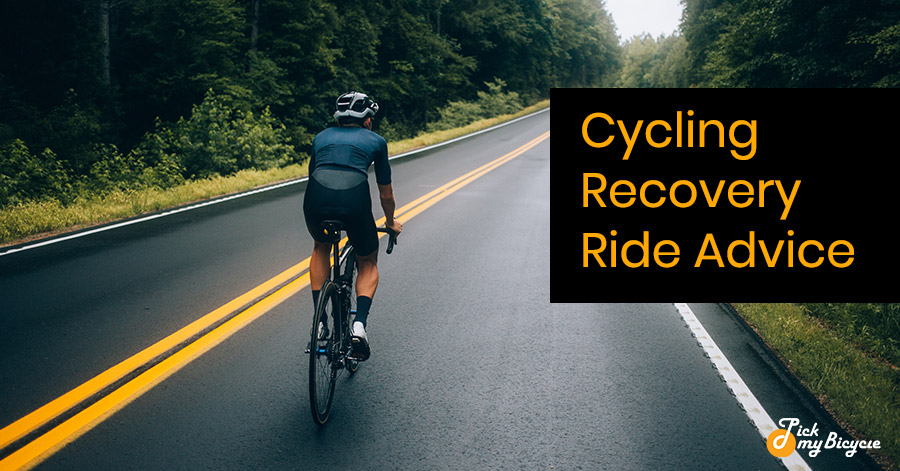What is a Recovery Ride in Cycling?
A recovery ride will help you bounce back from a long-distance cycling tour. You can experiment with a recovery bicycle ride to relax and give your body a break after a tough ride. Sometimes, a long-distance ride can make you feel hectic and you might feel the riding routine to be monotonous.
A recovery ride is the icing on the cake where you just go with the pedaling flow to ease your blood flow and set things right. The more you pedal, the sooner your recovery. It will help you to get ready for the next riding session as well.
What Is A Recovery Bicycle Ride?
A recovery bicycle ride is an essential riding schedule task to keep the blood flowing. It is usually done on flat roads for a time period of an hour to 90 minutes. A hard training week mandatorily needs a recovery bike ride to give your body the space to heal and recover and get ready for the hard routine.
A recovery bike ride is one of the favorite modes for many cyclers as it is just spinning your legs without exerting much pressure and stress. No matter the type of bike you have, a recovery ride will help you get off the leg soreness and increase the blood flow to the damaged tissues in your legs and focus areas.
Tricks To Master A Recovery Bicycle Ride
1.Work on a schedule

Plan a recovery ride and work on it. It is highly recommended not to skip the schedule as it might disrupt the entire routine. Ride for the next block can be done without any interruptions if you have a regular recovery bicycle ride. Once a week or twice a week is the recommended frame for a recovery ride. Increasing frequency or reducing the frequency may have adverse effects on your health as well as your body muscles.
Ensure to maintain this frequency if you are riding for more than 20 hours a week. It is generally recommended that beginners take things slowly and steadily without rushing things. Tough rides and extended hours may be hard for beginners and there are high chances of them zoning out. If you are not able to maintain the frequency, make sure to take your cycle to the roads at least 30 minutes once a week.
2.Ride a different bike

Riding a different bicycle will help you relax. If you own a mountain bike or a road bike, it might feel like you are on track. So, try riding a basic bicycle that will allow for easy spinning of your legs.
Your legs should not feel the strain when you are on a cycle. Also, it should assist in the flow of blood. A hard pedaling system will spoil the entire purpose and may cause more damage to the tissues.
3.Carry gadgets

Gadgets to keep you off track are a good option because they will let you read your heart rate. Your heart rate should be a quarter of the heart rate of your regular routine. If you have a heart rate monitor, you can consider taking it with you to understand your heart rate.
Use your mobile phone wisely on a recovery ride. If you are not getting used to the concept of recovery rides and failing to pedal stress-free, try the option of reminders to get you on track. You will get used to it once you become completely aware of it.
4.Choose a flat road

A flat road is the most suitable form for carrying out a recovery ride as it will not demand pressure and push from your side. A flat road is the easiest to keep your legs spinning without changing positions.
This will help the blood flow to be in good shape and will also help in faster recovery of your damaged tissues and also gives relief from aches and pains in any part of your body.
5.Cadence drills

Hig-cadence sprints will help your body understand the need for relaxation and it will automatically start functioning. It is advisable to keep your cadence at 90 rpm at slow gears and slow speeds.
Ensure to keep this rpm as subtle as possible to achieve the desired outcomes. Sprints in your recovery ride should be made easy. Pedaling should be done comfortably concentrating more on your heart rate.
6.Check the weather

It is advisable to check the weather conditions before you pull out your gear for cycling. Going for a recovery ride in nominal weather conditions will help you achieve the expected outcome.
Extreme weather conditions can make your body unsuitable for the ride and can cause nausea or irritations. This can have adverse effects on your body thus reducing the room for relaxation.
7.Work on your mindset

You have to get a hold of the right mindset when you are on for a recovery ride. It is always good to go alone as this will encourage you to work more on your relaxation.
Going with your fellow riders or family members can increase your focus on doing more sprints in a limited time. This will not provide you with relaxation for your muscles. Additional strain is caused on the muscles when you enter race mode. Make sure to fix your mind for the recovery ride.
How Can a Recovery Bike Ride Help your Body?
A recovery ride has the potential to help your body recover and get ready for the next session. Rest and recovery are misunderstood where rest is a term associated with providing complete rest without actually performing any physical activity.
Recovery is performing your ride routine by exerting reduced pressure on the pedals. It is done by varying your speed, distance, physical exertion, and heart rate. A recovery ride assists the body in positive ways. Those include,
- Removal of metabolic waste
- Increasing the blood flow
- Providing relief to damaged tissues
- Relaxation of muscles
- Restoring energy
- Working on blood lactate levels
- Frees your mind
Things to Carry on a Recovery Ride
1. Backpack
The recovery ride won't need much of things but basic essentials such as your wallet, phones, and AirPods can be kept in a backpack. Ensure that the backpack is not made of heavy fabric. It should be light and should not disturb you on track.
2.Sun protection
Although, recovery rides are for a period of 60 minutes to 90 minutes, you might need sunscreen to protect your skin from the sun. always ensure to keep sun protection cream in your backpack.
3.Water bottle
The recovery ride is more of relaxation where the need to consume water frequently does not arise. Even though, to be on the safer side carry a small bottle with you.
4.Heart rate monitor
One of the essential components to be carried out for a recovery ride to maintain a nominal heart rate. Ensure to charge your device before you step out. Also, make sure to keep an eye on the heart rate. An elevation in the rate might eliminate the room for relaxation.
5.Headlight
If you are opting to go for your recovery rides at night, it is advisable to fix a headlight to avoid any mishappenings. Headlights will also guide you on the roads and will keep you aware of any bumps and pits on the road.
6.Route map
If you are choosing a new route for your recovery ride, it is a good option to take your map. Although, the trip is of short distance, having a map handy will help you in unexpected situations.

Frequently asked questions
1.Is a recovery ride advisable for beginners?
Recovery rides can be done by beginners but are not highly advisable. These rides are done by cyclers who take up 20 hours of cycling in a week.
2.What is the recommended time for a recovery ride?
Recommended duration for recovery rides is usually between 60 to 90 minutes. Riding your bike more than this can cause stress on your legs and also can result in a rise in your heart rate.
3.Should I mandatorily do a recovery ride after a week of the training session?
Yes. recovery rides are mandatory after a tough training session to bring back your body to normalcy. It is also highly essential to get your body trained and ready for the next session. It is highly recommended not to skip or take the recovery rides lightly.
4.Should I consult my coach beforehand?
Coaches possess a fine knowledge of things on every aspect of cycling. It is a wise move to consult your coach before you start your recovery ride. You can clear all your queries regarding the same as well.
5.At which time of the day should I go for a recovery ride?
The time for your recovery ride entirely depends on your convenience. It can either be day or night. The only consideration is that you should be comfortable enough to achieve the purpose of the ride.
Conclusion
Now that we have come to the conclusion, we are quitting with the satisfaction that our article has served its purpose entirely. We, highly hope that our expert guidance has assisted you in gaining enough knowledge on the head. As you are completely aware of all the techniques and tricks to be followed to master a recovery bicycle ride, wear your bike helmet and step out to reap the pros of a recovery bicycle ride.
Disclaimer - The images inside the article were collected from the internet. We do not own any of them.

